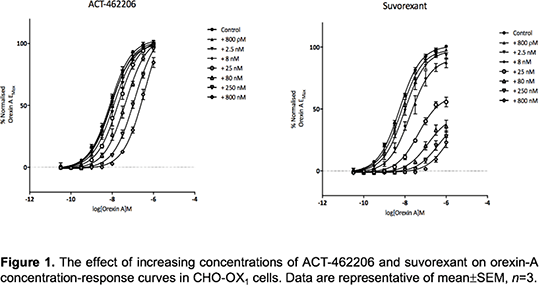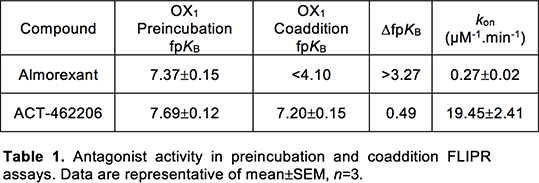| 239P London, UK Pharmacology 2016 |
Characterising the functional kinetics of OX1 antagonists using a novel fluorometric imaging plate reader (FLIPR) assay
Introduction: Mounting evidence has shown that a compound’s kinetic properties can influence its duration of clinical action1. However, despite the potential benefits of tailoring the kinetic properties of preclinical compounds, optimisation of such parameters has been hindered by the limitations of traditional assay techniques. The aim of this study was to evaluate the kinetic properties of unlabelled orexin-1 receptor (OX1) antagonists using a functional assay.
Methods: The ability of OX1 antagonists (80μM - 2.5nM) to inhibit the responses to an EC80 of orexin-A ligand was tested in CHO cells stably expressing OX1. Antagonist activity was assessed after a 5 minute antagonist preincubation period (37°C) and in coaddition with the orexin-A challenge. Antagonist potency was calculated using a modified Cheng-Prussoff equation and the difference in antagonist potency between the two assays (αfpKB) was used as an estimate of antagonist association rate (kon). In order to characterise antagonist dissociation rate (koff), Schild analysis was conducted by performing concentration-response curves of orexin-A (1μM - 31.6ρM) in the presence of the OX1 antagonists ACT-462206 and suvorexant (800nM - 800ρM, 5 minute preincubation) (37°C). Kinetic profiling of unlabelled antagonists was generated in SF21 cell membranes expressing OX1 using Motulsky-Mahan radioligand binding methods1, using [3H]-SB-674072.
Results: Although for a number of antagonists, including ACT-462206 and almorexant, αfpKB was in line with kon, there was no coherent link observed between the two parameters across a wider range of antagonists. ACT-462206 displayed fully surmountable antagonism, whereas suvorexant caused concentration-dependent depression of the maximal orexin-A responses. The dissociation kinetics of suvorexant were much slower than those of ACT-462206, with koff values of 0.0068±0.0003min-1 and 0.64±0.12min-1 (mean±SEM, n=3) respectively.
Conclusions: While studies into association rates yielded unclear results, pseudo-insurmountability in Schild experiments appeared to correlate with koff, in line with previous studies2. This demonstrates that dissociation kinetics can be qualitatively assessed using a widely available assay technology, providing a functional platform to optimise for desirable compound kinetics early in the drug discovery process.
References:
(1) Dowling MR and Charlton SJ (2006). Br J Pharmacol 148:927-937.
(2) Mould R et al. (2014). Br J Pharmacol 171:351-363.



